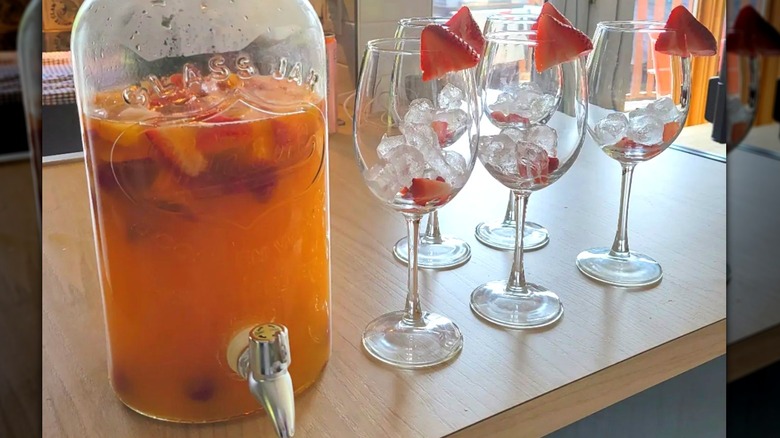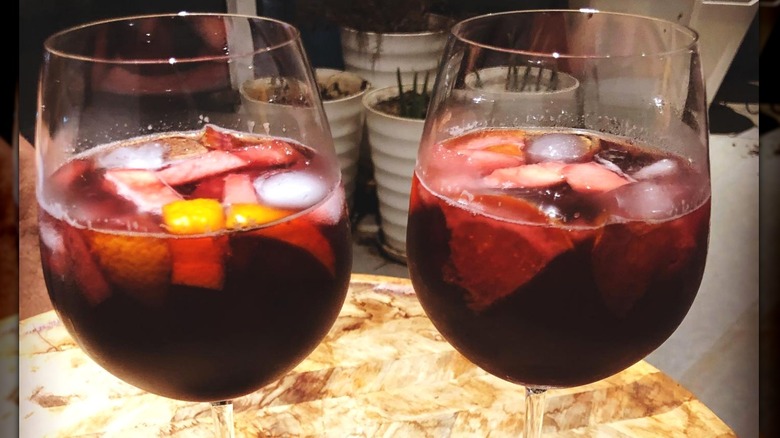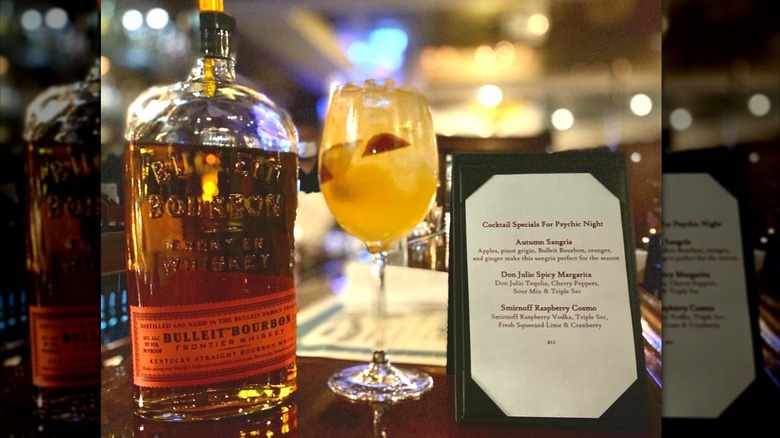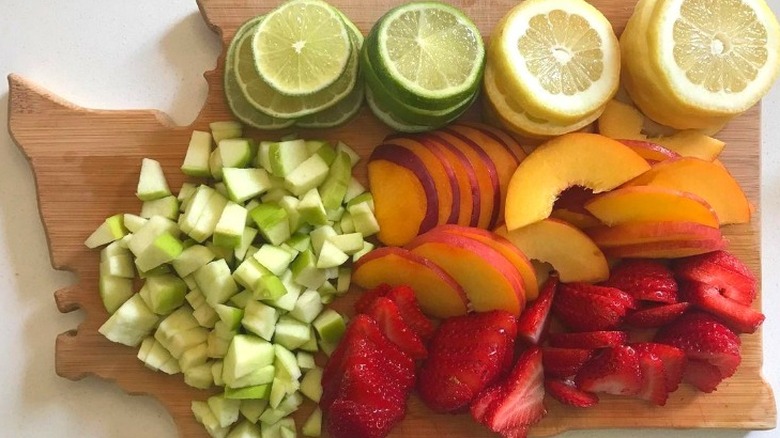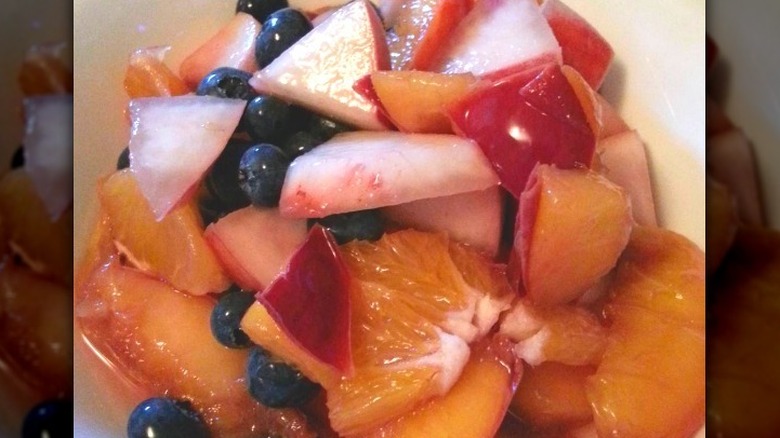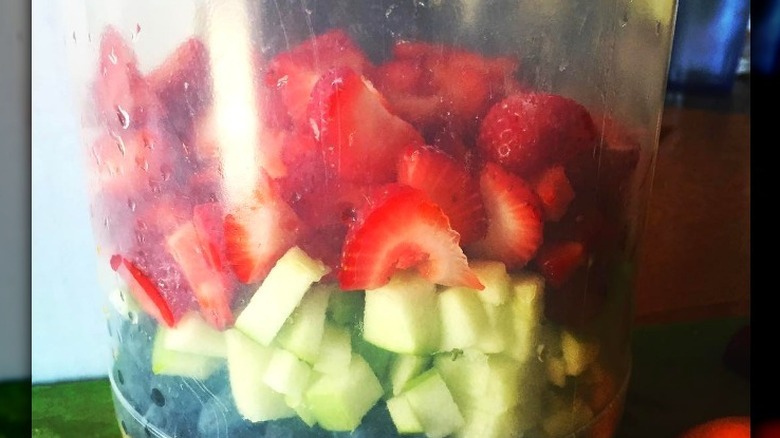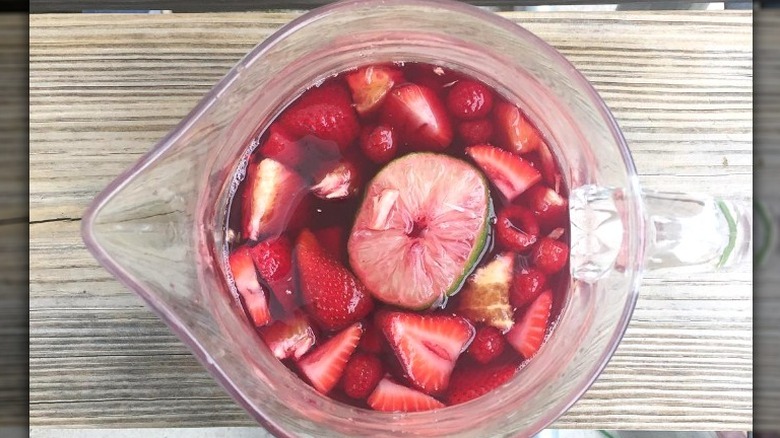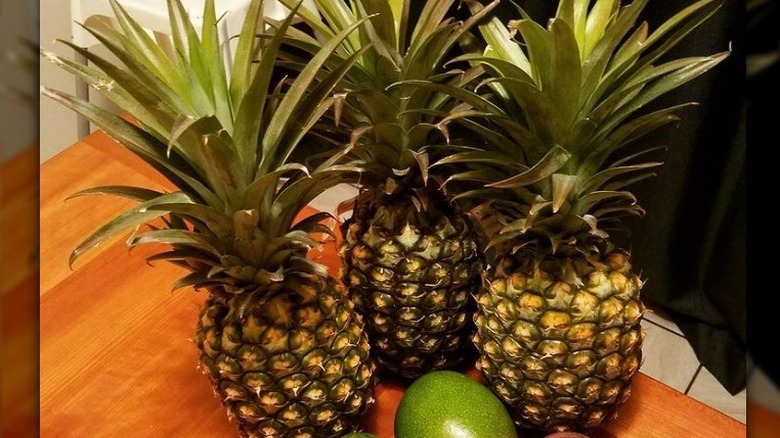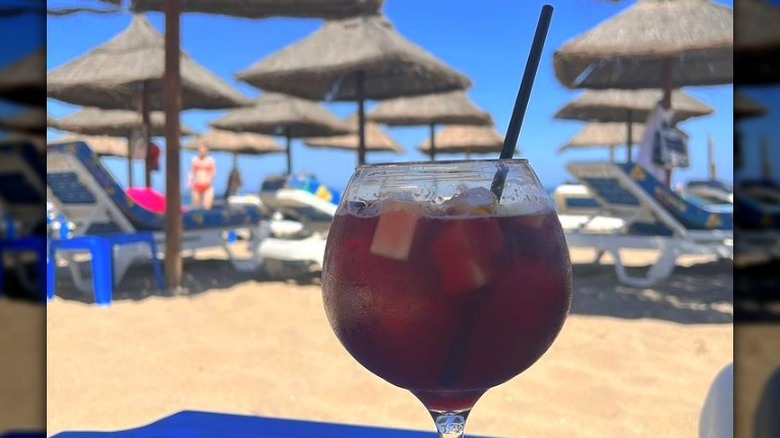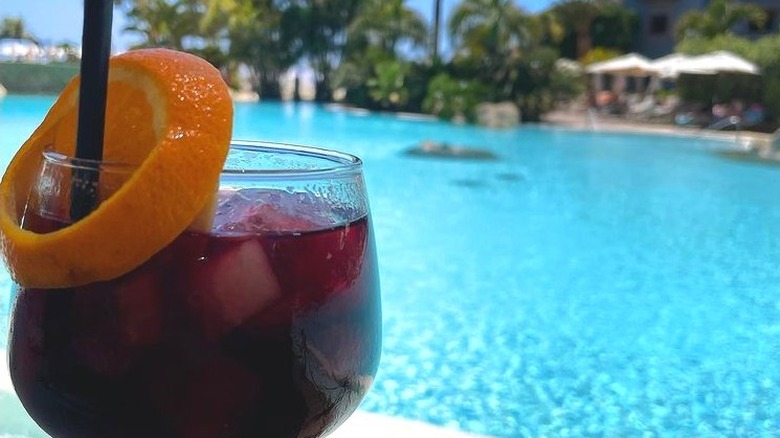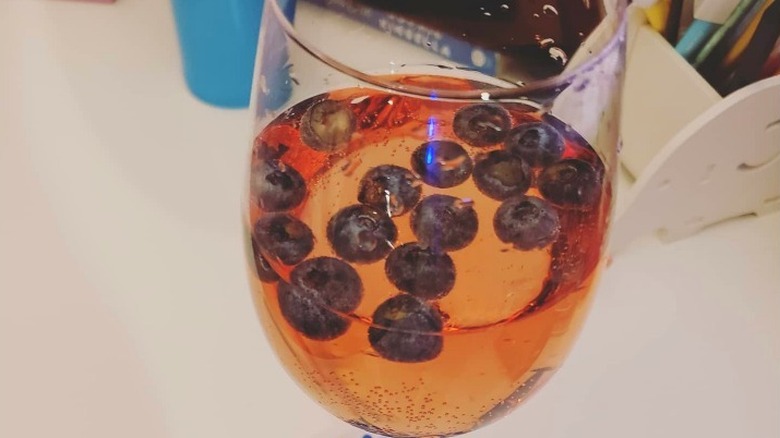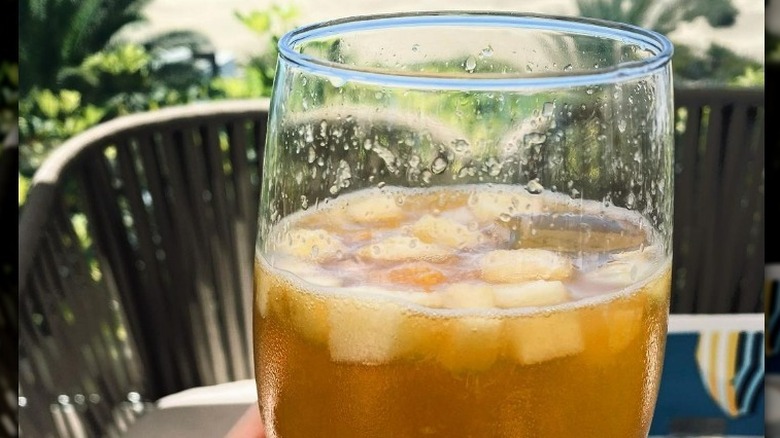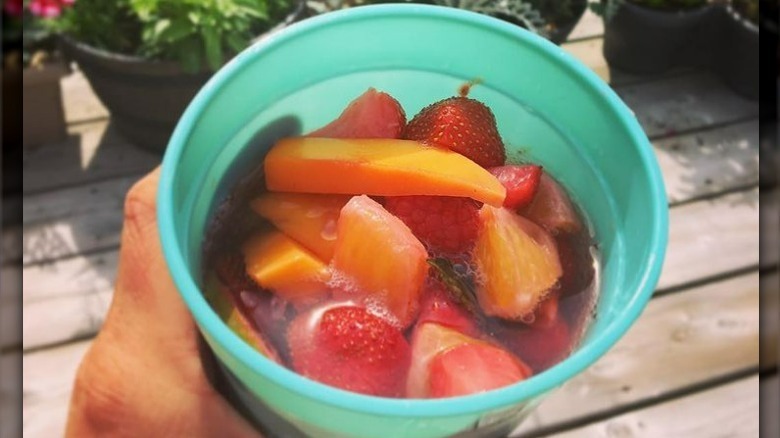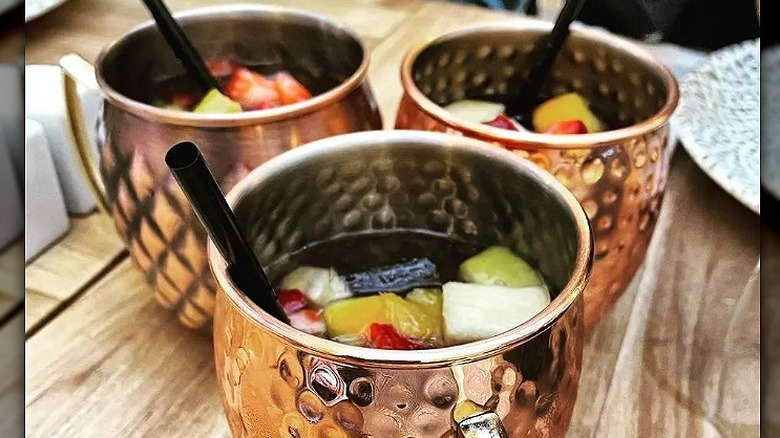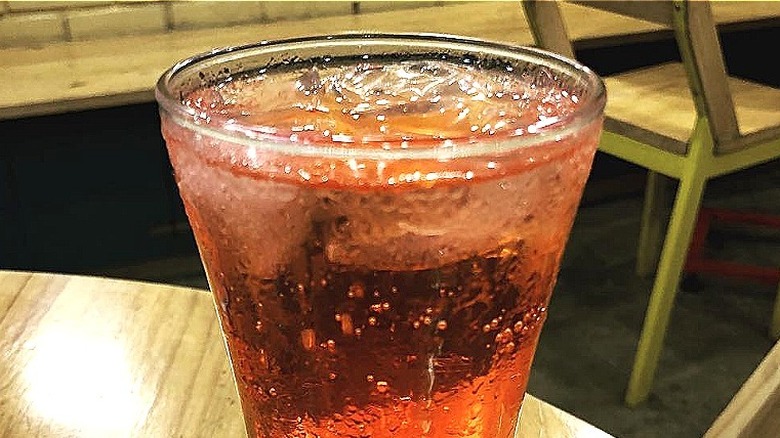Mistakes Everyone Makes When Making Sangria
When it's the height of summer, the temperature tips into the high 80s, and the combo of heat and humidity have you both parched and sweating, chances are, that an ice-cold glass of sangria is the remedy you need. Whether you're at a summer BBQ, a 4th of July event, or a birthday party, there's nothing quite like sangria to help provide the refreshment you need.
While wine mixed with fruit sounds like it's simply a more adult punch, sangria has been refreshing Europeans for hundreds of years since its origin (via Spanish Sabores). After its American debut in New York at the 1964 World's Fair, sangria has become a favorite thirst-quencher for communal drinkers and summertime partiers.
But there's more to sangria than just throwing fruit in red wine and hoping for the best. While you can easily improvise your own sangria to your own taste, there are a few guidelines that, if followed, will up your sangria game and make the drink significantly more delicious and potent.
Choosing the wrong wine
Not every red wine is ideal for sangria. Since red wine is the base of a red wine sangria, take a second before reaching for a bottle of merlot or port. According to Cookie and Kate, an important aspect of choosing the right base for your sangria is ensuring that the wine you pick is low in tannins. Tannins are naturally created during the winemaking process due to grape skins and seeds. Tannins tend to give the wine a bitter flavor.
This is important because tannins do not taste good when they're cold, and sangria is typically served chilled. Wines that are high in tannins are also not great for pairing with fruit. If you're looking for an affordable but low-tannin suggestion for your sangria, consider a Garnacha or a Pinot Noir. Both are relatively low in tannins, which means your sangria won't need an extra dump of sweetener to cover up the bitterness. If you're opting for a white wine sangria, then Pinot Grigio and Sauvignon Blanc are good options (via Paso Robles Wine Country).
Adding the wrong liquor
Some people like their sangria extra boozy. There's little in the way of making a bad call with regard to mixing hard liquors with sangria; rum, bourbon, and vodka all work quite well (via BlackTailNYC.com). However, if you're aiming for a more traditional red-wine sangria flavor then you should opt for something like brandy (via Inspired Taste). Brandy is more of a fruit-based liqueur with a naturally sweet taste that'll pair well with sangria but will prevent the mix from becoming overly sweet.
Masterclass has a guide to brandy, which can help you decide on the right spirit that is suitable for your sangria. If you're not into brandy, then blended whiskey is a good alternative. Rum is a great option if you're looking to make your sangria more tropical. Adding a touch of orange liqueur is another way of adding a more concentrated citrus flavor to your sangria.
If you're making a white wine sangria, try to stick with clear liquors; the top two choices are vodka or tequila. And, as always, remember to "measure with your heart" (just don't add too much).
Using the wrong fruit
It's tempting to treat making sangria as a sort of catch-all for fruit you're about to toss out, isn't it? Rest assured that you, and your guests, will figure it out really quickly when their sangria turns into a slushie. While there are no established "rules" per se with regard to the fruit you can add to sangria, Foods Guy recommends adding combinations of fruit that harmonize well with the notes of the wine itself. Depending on which wine you're using, the fruit can include oranges, strawberries, and peaches.
Traditionally, apples, berries, and lemons are popularly used in white wine sangrias (via Minimalist Baker). According to Gimme Some Oven, it's important to make sure that whichever fruit you add to your sangria is both fresh and has been chopped into small pieces or slices. Also remember that variety is the spice of life, especially when it comes to sangria. At the very least, you should add at least two fruits to your mixture. Just make sure that one is a citrusy fruit and the other is a non-citrus fruit to attain a wonderful juxtaposition of flavor and textures.
Peeling your fruit
When it comes to fruit, the flavor isn't limited to the flesh: If you've made any recipe containing lemon zest then you know that often the skin or the rind of many fruits contain a potent, fragrant, and often flavorful oil just asking to be added to your sangria. According to Field and Stream, whether or not the fruit is peeled is a matter of personal preference. While retaining the rind can make eating the fruit a little bit more difficult, leaving the fruit cut but unpeeled can have its advantages.
Unpeeled fruit tends to take longer to disintegrate when it's submerged for a long time. Citrus fruits like oranges have a habit of coming apart if left in liquid for a long time, and leaving on the rind can help give the sangria an overall smooth texture. Additionally, unpeeled fruit might also be easier to eat out of a glass of sangria. If you choose to leave the fruit skin on, just make sure you don't leave the fruit in there for too long as the bitter oils can start spoiling the drink.
Not letting the fruit soak for long enough
If you toss your fruits into sangria right before your first guest arrives, then they'll be enjoying a slightly sweetened wine filled with fruit. While sangria looks like a drink you can make quickly with few ingredients, it's also something that tastes better when you give it the right amount of time.
According to BlackTailNYC.com, in order to make a good sangria, the fruit should soak in the drink for at least 30 minutes to allow the flavors to mingle. It's best to refrigerate your sangria until it's ready to serve to allow the flavors to become accustomed to one another.
It's definitely worth it to give yourself just a little bit of time to make sangria. The patience will certainly pay off as the fruit will give the wine those extra notes of flavor, not to mention a fruity, enjoyable fragrance.
Letting the fruit soak for too long
While sangria should be allowed to soak for some time, it certainly should not be treated like soup stock. It's one thing to let your fruit coalesce and settle within the sangria to bring out its fuller flavor, but soaking fruit for too much time can and will eventually turn your refreshing beverage into a concoction filled with swimming bits of fruit and pulp. Refrigerating sangria can help prevent your fruit from falling apart in sangria and allow the drink to contain more fruity flavors, especially if you plan to leave the fruit in overnight (via BlackTailNYC.com).
However, not all fruit can withstand that amount of liquid over a long period of time. While tougher fruits like apples will soften as they soak, other, more water-heavy fruits like oranges and blueberries will start to break apart over time as they sit in liquid. If you plan to leave the more sensitive fruits in the fridge overnight, then consider straining out sangria and replacing the fruit, prior to serving.
If you're using fresh fruits in sangria at room temperature, then make sure it doesn't soak them for over two hours. Also, as with any drinks containing fruit, it's essential to remove any seeds.
Choosing the wrong pairing of fruit and wine
In order to ensure that the fruit matches the flavor of your wine, it's important to choose properly pair your wine with the right kind of fruit (via Foods Guy). Taking the time to consider each fruit and the specific flavors it brings to the sangria can help hone the flavor and turn the sangria from a refreshing drink to something that truly sings. The right fruit for your wine depends on whether you're using red or white wine. Additionally, some fruits will work better with each other than other pairings.
While oranges are typically used in red wine sangria, according to BBC Good Food, oranges also go quite well with white zinfandel. And, while peaches are a popular addition to white wine sangria, they also pair very well with a red rioja. Far from establishing restrictive "rules," fruit and wine pairings should serve as a broad guideline. Experimentation is highly encouraged when making sangria.
Serving lukewarm sangria
One of the most important secrets of serving delicious sangria isn't in the wine, the fruit, or a special liqueur, it's simply about keeping the sangria as cold as possible (via BlackTailNYC). One of the easiest ways to chill sangria is to leave it in the fridge until it's time to serve. Just ensure you hold back on any ingredients like club soda till right before the moment you're about to enjoy your sangria.
According to Family Nano, putting all the ingredients together and letting them chill in the fridge overnight is a good way to chill sangria. Club soda or any fizzy additions will go flat if left in the fridge for too long, so they should be added right before this drink is served. Much like soda, sangria tastes best when it's col and still effervescent. There might be nothing worse for sangria than letting it reach room temperature.
At that point, this once tart and refreshing drink becomes far too cloying, not to mention that the fresh fruit will begin to soften within the glass and give your drink the consistency of a chunky soup. Sangria is a drink that maintains its delicate balance by remaining cold. Unless it's chilled, it's just not sangria.
Serving watered down sangria
According to Fine Cooking, you should never put ice directly into a pitcher of sangria as that's a quick way to lose the flavor as the ice melts. While you should try to keep your sangria chilled for as long as possible, adding copious amounts of ice cubes will result in a watered-down beverage unless you keep it in the fridge.
If you're going to use ice with your sangria, make sure you pour it over the ice in a glass instead. That way, your drink will be cold and you won't water it down too much with fresh ice. There are also other methods to keep sangria chilled, such as layering a punch bowl over another filled with ice.
The Kitchn suggests freezing a tray of fruits to help keep your sangria at a chilled temperature in lieu of using ice cubes. That way, your drink will stay cold, and the thawing fruit will not water down your drink and you can enjoy the beverage for much longer.
Making it too sweet
Since sangria already contains fruit, it's already a pretty sweet drink (via Tasty Ever After). However, if you're looking to make it extra sweet or balance out a particularly strong liquor, then you've got a lot of options to choose from.
Just make sure you don't choose regular white sugar. Not only will sugar turn your sweet drink into something borderline tooth-achingly and sickeningly sweet, but much of the added sugar also may not properly dissolve, resulting in sedimentation at the bottom of your glass (via Que Rico Tapas).
Since sangria is naturally sweet, try adding fruits that lean more towards tart flavors. VinePair suggests adding granny smith apples, or a more acidic liquid such as lemonade. If you really want to sweeten sangria without using sugar, then try adding honey, agave nectar, or even simple syrup. Whichever form you choose, just make sure you add it in sparingly and you'll end up with a perfectly balanced sangria.
Adding too much liquor
There's a fine line between getting a little tipsy and tripping over yourself. According to Spoon University, sangria is the perfect happy hour drink to consume with friends as it will give you a pleasant buzz without high levels of intoxication. If you're making sangria for your guests and you want them to have a good time, the best thing you can do is to pull back on how much liquor you're adding to your beverage. Regardless of which hard liquor you're adding to your sangria, it's best to add just enough to give a taste of alcohol without that strong kick of alcohol that's hard on the tastebuds and the stomach.
Remember that the keyword in a good sangria should always be refreshing. You're making a drink that helps your friends have a fun time while they're drinking, and too much alcohol can be far too overwhelming for some people. Not to mention that overloading on the booze can severely offset the taste of sangria. Too much of a good thing can turn your beverage from sweet and invigorating to an intensely burning drink.
Overloading it with fruit
Fruit is an important component of sangria, but much like liquor, it is possible to have too much of a good thing. Sangria should taste like wine that has been chilled and infused with fruit flavor: That's a lot harder to do when you tilt your glass and are mostly hit with several wet fruits in the face (via BlackTailNYC).
According to Epicurious, you don't need to limit yourself to just two fruits although there are a number of fruit duos that work particularly well. Sometimes, the simplest recipes are the ones that trade overcomplicated flavors for something that is a little more refined.
Also, considering volume displacement, too much fruit will take up a lot of space, not just in your pitcher or punch bowl, but also in your glass. More fruit means less liquid, which is really what your sangria should be about. Additionally, too much fruit can increase the chances of spillage.
Not measuring your ingredients
Sangria has a reputation for being a kind of chaotic recipe that doesn't need to follow the rules. And yet, the best way to make the perfect sangria is to take the time to measure each ingredient. Even a slight level of prep can ensure that you create a perfect-tasting sangria.
G-Free Foodie demonstrates a method for doing this on the micro-level by making your own individual glass of sangria. This can be especially useful as it will help you plan out your own special sangria recipe on a smaller scale. And, once you've mastered this, you can begin making sangria in a pitcher by properly measuring out the ingredients.
It's one thing to grab a sangria recipe off the line and hope for the best, but it's another thing to practice, innovate, and create your perfect sangria concoction. The result is bound to amaze your guests.
Not adding a carbonated drink
Considering the sweet tartness of sangria, a few bubbles can help brighten up your drink in the right way. If you're interested in adding a little fizz and suddenly creating a sparkling sangria, you're in luck; almost any flavorless or lightly flavored carbonated drink will do wonders for sangria. Black Tail NYC.com suggests using soda water, seltzer, and flavored sodas to add just a little extra fizz to your sangria.
If you do choose to add a carbonated drink to the sangria, make sure that it's the final ingredient that is added to the drink aside from a light fruit garnish. The carbonation should taste as fresh as possible and this is unlikely to happen if you leave the sangria overnight in the fridge. It's best to pour in the soda just before serving or after you've poured the sangria. The more you hold off on pouring in the fizz, the better the final product will be in terms of taste and consistency.
